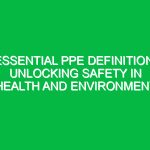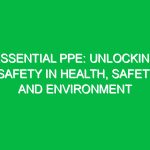Good morning team! Today, we’re going to discuss a crucial topic that impacts our Health, Safety, and Environment (HSE) practices – Bloodborne Pathogens. It’s essential to understand how to protect ourselves and our team members from these potential hazards to ensure a safe working environment. Let’s dive into the key tips and best practices for handling Bloodborne Pathogens effectively.
The Importance of Bloodborne Pathogens Safety
First and foremost, let’s clarify what Bloodborne Pathogens are. These are microorganisms such as viruses and bacteria that are present in blood and other body fluids and can cause disease in humans. In our line of work, exposure to Bloodborne Pathogens can occur through needle sticks, cuts from sharp objects, or contact with infected blood or bodily fluids.
Understanding and following proper safety protocols when dealing with Bloodborne Pathogens is crucial in preventing infections and illnesses. By adhering to these safety measures, we not only protect ourselves but also our colleagues and the community at large.
Key Safety Tips for Handling Bloodborne Pathogens
Now, let’s discuss some essential safety tips that all team members should keep in mind when working in environments where Bloodborne Pathogens may be present:
- Use Personal Protective Equipment (PPE): Always wear appropriate PPE, such as gloves, masks, and protective clothing, when handling potentially infectious materials.
- Handle Sharps Safely: Dispose of needles, blades, and other sharp objects in designated sharps containers to prevent accidental injuries.
- Practice Proper Hygiene: Wash your hands regularly with soap and water, especially after handling potentially contaminated materials.
- Follow Proper Disposal Procedures: Dispose of contaminated materials in designated biohazard bags or containers according to established protocols.
- Receive Vaccinations: Ensure you are up to date on vaccinations for diseases such as Hepatitis B to protect yourself from potential infections.
Real-Life Scenario: The Importance of Proper PPE
Imagine you’re working in a healthcare setting where you come into contact with patients’ blood samples daily. One day, while handling a sample, the vial accidentally breaks, splashing blood on your hands. This is a critical moment where wearing gloves as part of your PPE can prevent direct exposure to Bloodborne Pathogens and reduce the risk of infection.
By following proper safety protocols and wearing the necessary PPE, you not only protect yourself but also uphold the safety standards of the workplace.
Regulations and Compliance
It’s essential to be aware of and comply with relevant regulations and company policies regarding Bloodborne Pathogens. By following these guidelines, we ensure that our work environment remains safe and free from potential health risks.
Remember, our commitment to safety doesn’t end with this Toolbox Talk. It’s an ongoing effort that requires everyone’s participation and vigilance. By prioritizing safety and following best practices, we create a safer workplace for ourselves and our team members.
Conclusion
As we conclude today’s Toolbox Talk, I want to thank you all for your attention and dedication to learning about Bloodborne Pathogens safety. By applying the tips and practices discussed today, we can protect ourselves and our team members from potential health risks and create a safer work environment for all. Remember, safety is everyone’s responsibility!


